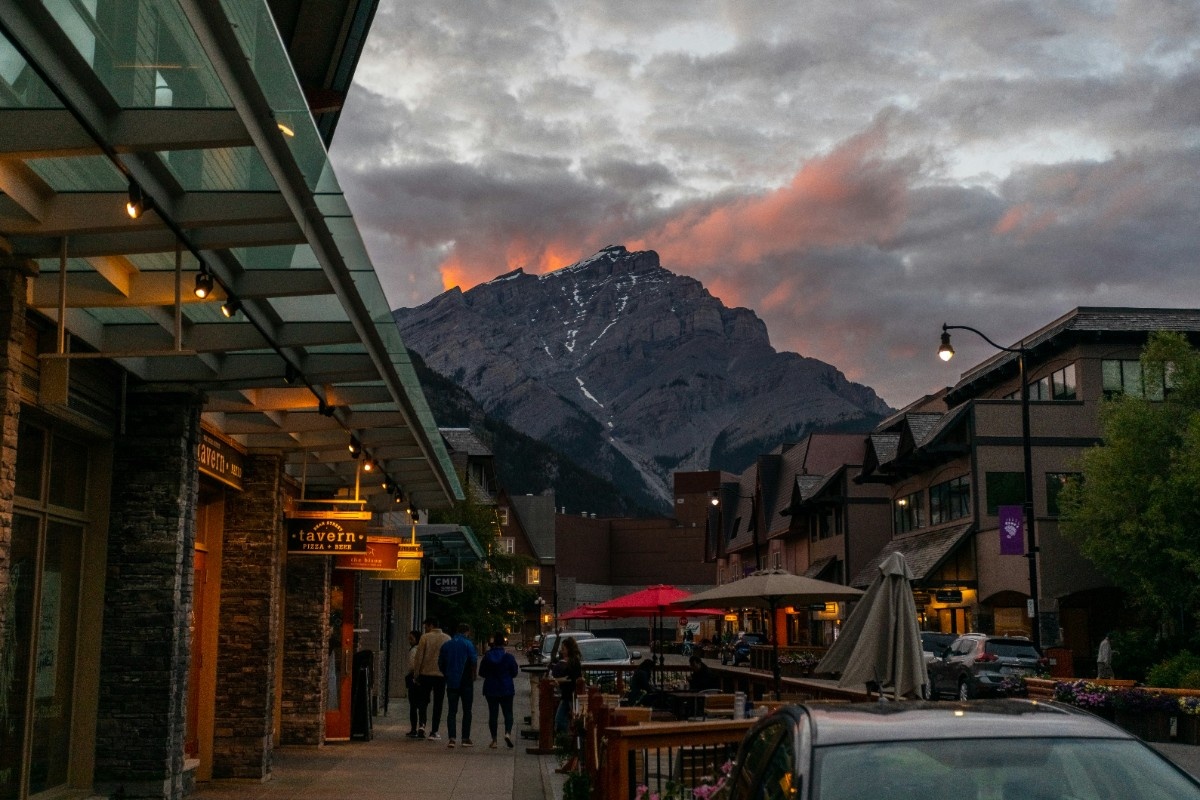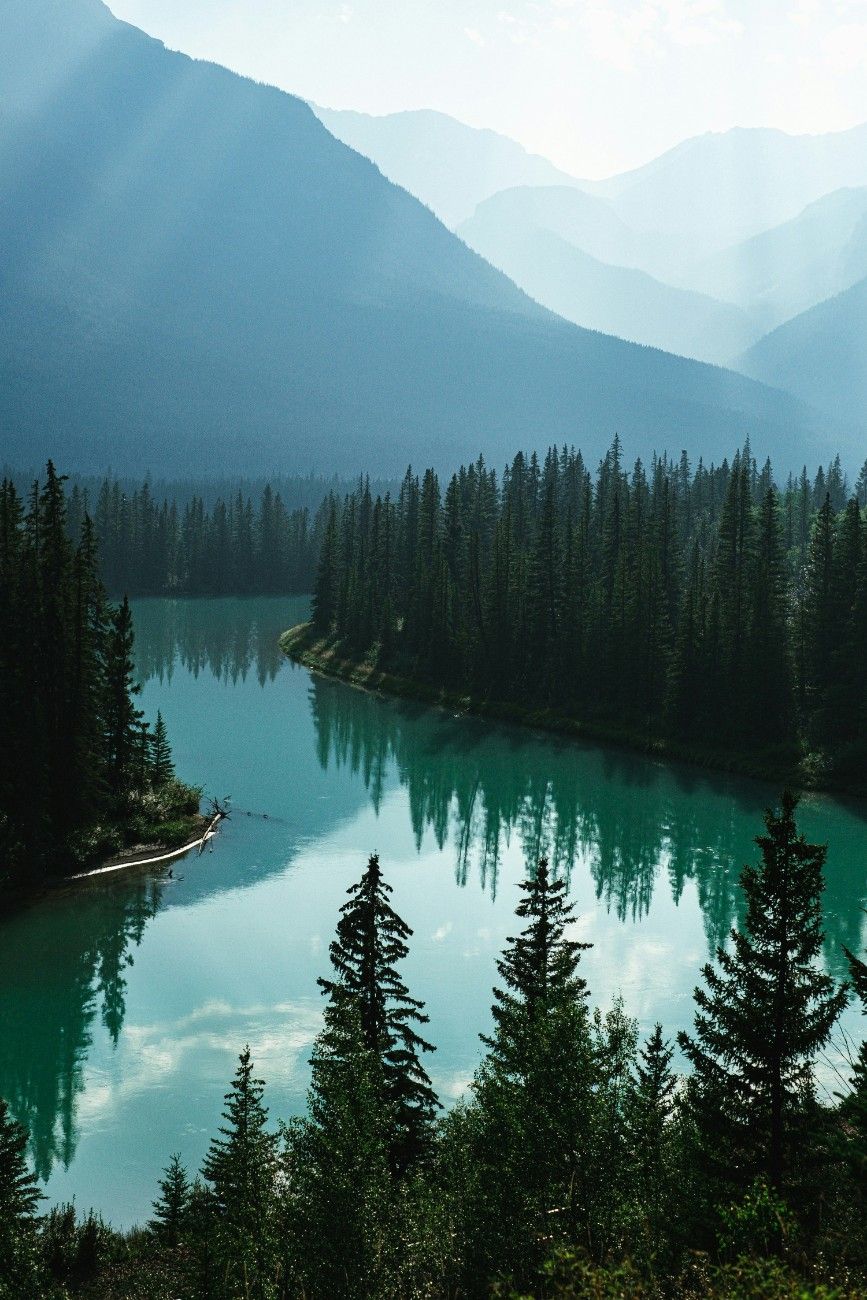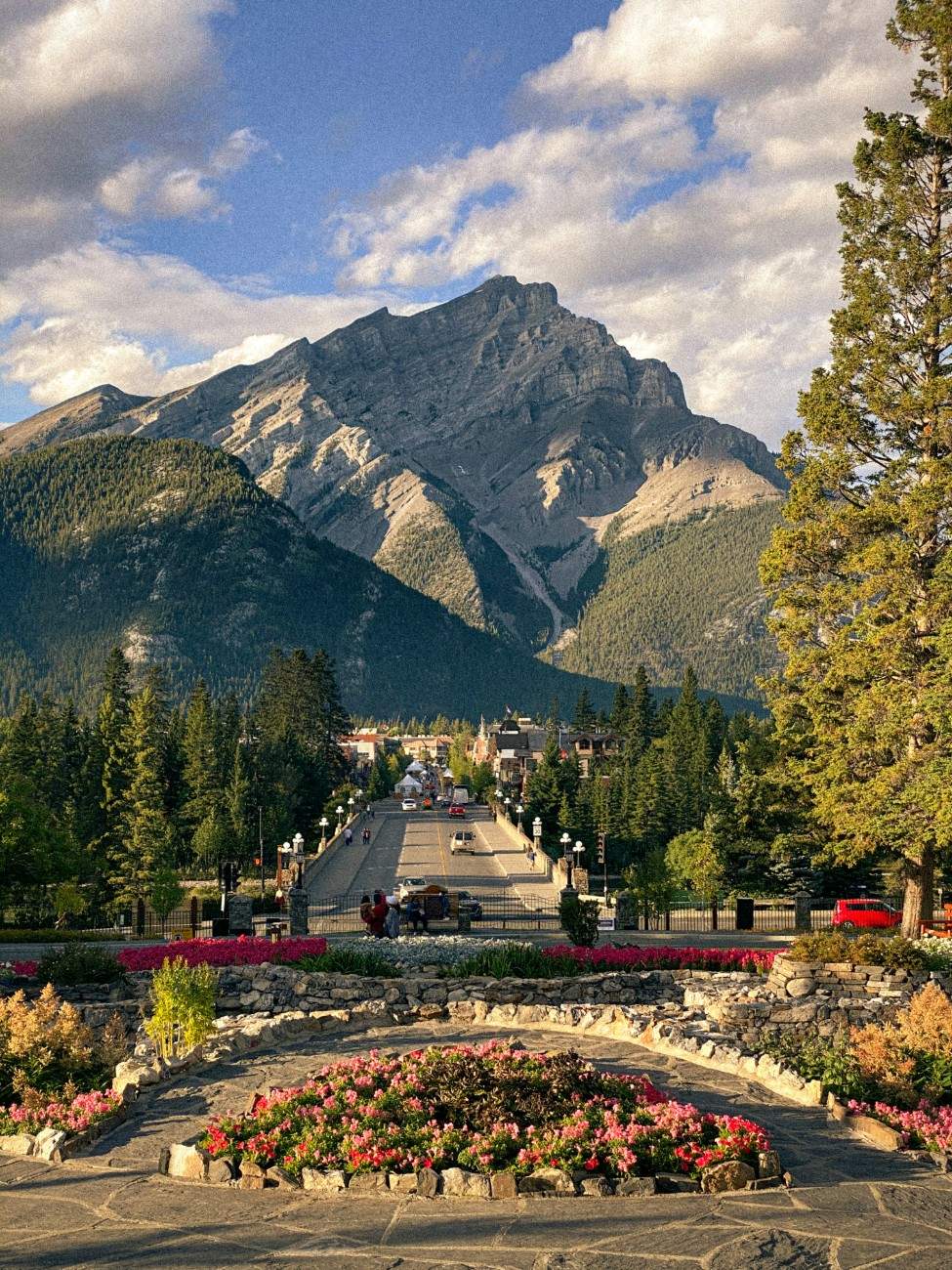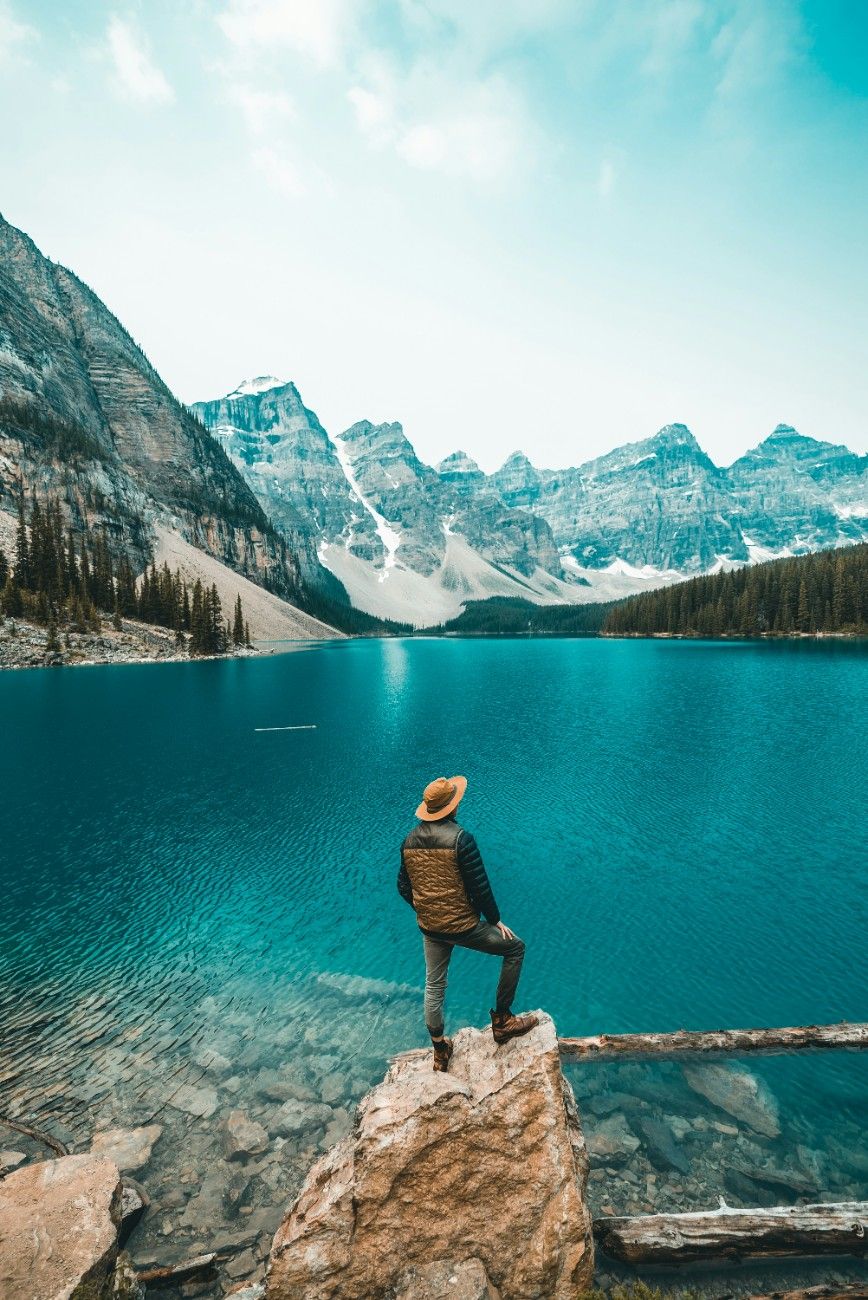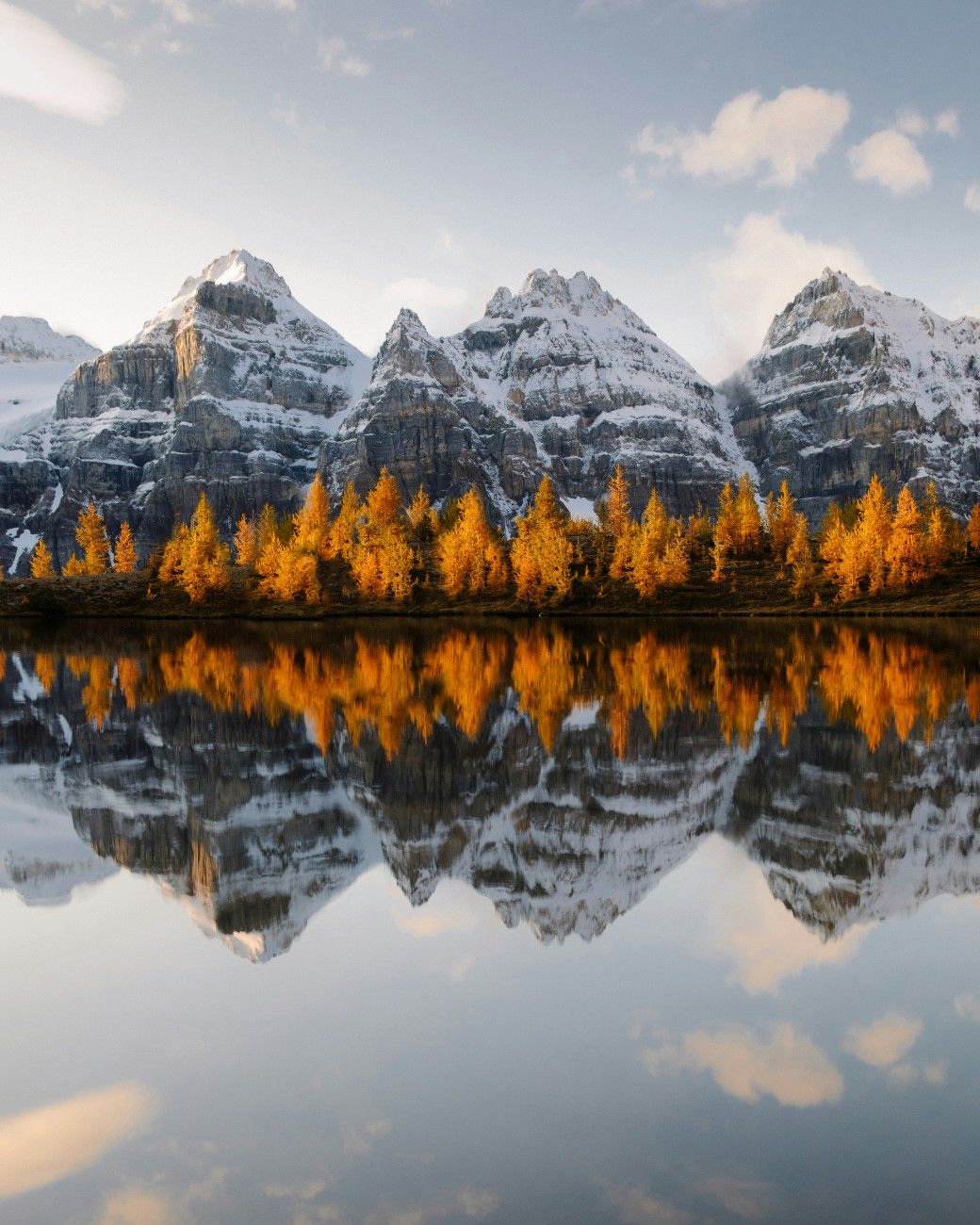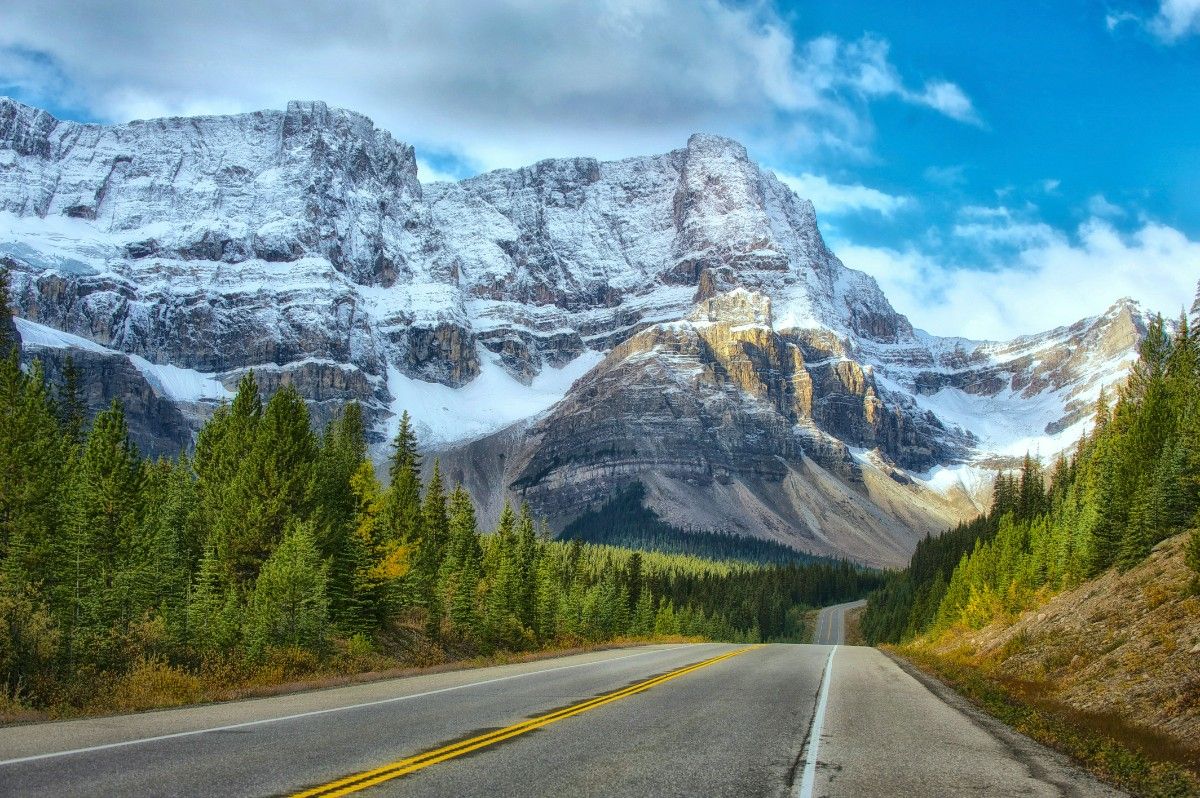A Wilderness Paradise
Banff National Park is a true wilderness paradise, offering visitors a chance to immerse themselves in the breathtaking beauty of the Canadian Rockies. Located in the province of Alberta, Canada, this iconic park spans an impressive 6,641 square kilometres, making it one of the largest national parks in the country. From the moment you enter the park, you are greeted by a landscape of soaring peaks, pristine glacial lakes, and lush valleys that seem to stretch on forever.
One of the most remarkable things about Banff National Park is the sheer diversity of its landscapes. The park is home to a wide range of ecosystems, from the rugged alpine tundra of the high peaks to the dense forests and wetlands of the valley bottoms. This diversity supports an incredible array of plant and animal life, from the majestic grizzly bear to the tiny pika, making the park a true haven for nature lovers and wildlife enthusiasts.
Whether you're hiking along one of the park's many scenic trails, canoeing on the turquoise waters of Lake Louise, or simply taking in the view from one of the park's many scenic viewpoints, there is no shortage of opportunities to discover the wonders of this incredible wilderness. With its stunning natural beauty, rich cultural heritage, and endless opportunities for adventure and exploration, Banff National Park is truly a destination like no other.
Iconic Lakes and Waterways
One of the most iconic features of Banff National Park is its stunning lakes and waterways. The park is home to some of the most beautiful and pristine bodies of water in the world, each with its own unique character and charm.
Perhaps the most famous of these is Lake Louise, a stunning glacial lake known for its turquoise waters and dramatic mountain backdrop. The lake is fed by the Victoria Glacier, which towers above the water and provides a constant flow of silt that gives the lake its distinctive colour. Visitors can explore the lake by canoe, or take a leisurely stroll along the lakeshore trail, which offers breathtaking views of the surrounding peaks and valleys.
Another iconic waterway in Banff National Park is the Bow River, which winds its way through the heart of the park and provides a vital source of water for the region's ecosystems. The river is a popular destination for fishing, with a healthy population of trout and other cold-water species, and is also a great place for a scenic float or kayak trip.
Other notable lakes in the park include Moraine Lake, known for its stunning turquoise colour and the dramatic Valley of the Ten Peaks that rise above it, and Peyto Lake, a glacier-fed lake that is often described as one of the most beautiful in the world. No matter which lake or waterway you choose to explore, you are sure to be struck by the incredible beauty and serenity of these pristine wilderness areas.
Geological Marvels and Landscapes of Banff National Park
The Formation of the Rocky Mountains
The geological history of Banff National Park is a fascinating story that spans millions of years. The park is located in the heart of the Rocky Mountains, one of the most iconic and recognisable mountain ranges in the world. The formation of these mountains began over 80 million years ago, when the North American and Pacific tectonic plates collided, causing the Earth's crust to buckle and fold.
Over time, the intense pressure and heat generated by this collision caused the rocks to metamorphose and uplift, creating the rugged peaks and valleys that we see today. The process of mountain building continued for millions of years, with successive waves of uplift and erosion shaping the landscape into its current form.
One of the most remarkable things about the geology of Banff National Park is the sheer diversity of rock types and formations that can be found within its borders. From the ancient sedimentary rocks of the Front Ranges to the younger, more metamorphosed rocks of the Main Ranges, the park offers a fascinating glimpse into the complex geological history of the region.
Visitors to the park can explore this geological diversity through a variety of means, from scenic drives and hikes to guided tours and interpretive programs. Whether you're a seasoned geologist or simply someone who appreciates the beauty and wonder of the natural world, the geological marvels of Banff National Park are sure to leave you in awe.
Glaciers and Ice Fields
One of the most striking features of the landscape in Banff National Park is the presence of glaciers and ice fields. These massive bodies of ice have played a crucial role in shaping the park's geology and ecology, carving out valleys, shaping mountain peaks, and providing a vital source of water for the region's ecosystems.
The most famous of these ice fields is the Columbia Icefield, which straddles the border between Banff and Jasper National Parks. This massive expanse of ice covers an area of over 200 square kilometres and is home to some of the most iconic glaciers in the Canadian Rockies, including the Athabasca Glacier and the Dome Glacier.
Visitors to the Columbia Icefield can take a guided tour onto the surface of the Athabasca Glacier, where they can walk on the ancient ice and learn about the role that glaciers play in shaping the landscape and regulating the Earth's climate. The icefield is also home to a number of stunning glacial lakes, including the Sunwapta Lake and the Tangle Falls, which are fed by the meltwater from the surrounding glaciers.
Other notable glaciers in Banff National Park include the Victoria Glacier, which feeds into Lake Louise, and the Bow Glacier, which is the source of the Bow River. These glaciers are not only beautiful to behold but also play a vital role in the park's ecology, providing a constant supply of cold, clean water that supports a wide variety of plant and animal life.
As climate change continues to impact the region, the glaciers and ice fields of Banff National Park are facing an uncertain future. Many of these bodies of ice are retreating at an alarming rate, with some scientists predicting that they could disappear entirely within the next few decades. This makes it all the more important to appreciate and protect these incredible geological wonders while we still can.
Flora and Fauna: The Incredible Biodiversity of Banff National Park
Diverse Ecosystems and Habitats
Banff National Park is renowned for its incredible biodiversity, which is supported by a wide range of ecosystems and habitats. From the rugged alpine tundra of the high peaks to the lush forests and wetlands of the valley bottoms, the park is home to an amazing variety of plant and animal life.
One of the most distinctive features of the park's ecosystems is the presence of the Rocky Mountains, which create a complex mosaic of habitats and microclimates. The mountains act as a natural barrier, separating the park into distinct ecological zones, each with its own unique flora and fauna.
In the subalpine zone, which occurs at elevations between 1,500 and 2,300 metres, the forest is dominated by Engelmann spruce, subalpine fir, and lodgepole pine. These trees provide crucial habitat for a wide range of species, including the iconic Canada jay, the red squirrel, and the snowshoe hare.
At higher elevations, the forest gives way to the alpine tundra, a harsh and unforgiving environment characterised by low-growing shrubs, wildflowers, and lichen-covered rocks. Despite the challenging conditions, the alpine tundra is home to a surprising diversity of plant and animal life, including the hardy mountain goat, the ptarmigan, and the tiny pika.
In the valley bottoms, the park's forests are dominated by lodgepole pine, white spruce, and aspen, which provide habitat for a wide range of species, including the elk, the mule deer, and the black bear. The park's wetlands and riparian areas are also incredibly diverse, supporting a wide range of plant and animal life, from the majestic trumpeter swan to the tiny calliope hummingbird.
Iconic Wildlife Species
One of the main draws of Banff National Park is the opportunity to see some of North America's most iconic wildlife species in their natural habitat. The park is home to an incredible diversity of mammals, birds, fish, and other wildlife, each with its own unique adaptations and ecological roles.
Perhaps the most famous of these species is the grizzly bear, a majestic and powerful animal that has become a symbol of the wilderness of the Rocky Mountains. Grizzly bears are omnivores, feeding on a wide range of plants and animals, from berries and roots to fish and small mammals. Despite their fearsome reputation, grizzly bears are actually quite shy and reclusive, and encounters with humans are relatively rare.
Another iconic species found in Banff National Park is the wolf, a highly social and intelligent animal that plays a crucial role in regulating the park's ecosystems. Wolves are apex predators, meaning they sit at the top of the food chain and help to keep populations of other animals in check. In recent years, the park's wolf population has been the subject of intense study and conservation efforts, as scientists work to understand the complex social dynamics and ecological roles of these remarkable animals.
Other notable wildlife species found in the park include the cougar, the lynx, the wolverine, and the bighorn sheep, each of which has its own unique adaptations and ecological niches. Birdwatchers will also find plenty to enjoy in Banff National Park, with over 260 species of birds recorded within its borders, from the majestic bald eagle to the tiny rufous hummingbird.
Of course, with such an incredible diversity of wildlife comes the need for responsible and ethical tourism practices. Visitors to Banff National Park are encouraged to observe wildlife from a safe distance, to avoid feeding or disturbing animals, and to follow all park regulations and guidelines. By doing so, we can help to ensure that these incredible species continue to thrive in the wilderness of the Rocky Mountains for generations to come.
Outdoor Recreation: Adventure and Relaxation in Banff National Park
Hiking and Backpacking
One of the best ways to experience the incredible beauty and diversity of Banff National Park is through hiking and backpacking. With over 1,600 kilometres of trails winding through the park's stunning landscapes, there is no shortage of opportunities for adventure and exploration.
For day hikers, the park offers a wide range of trails suitable for all skill levels, from short, easy walks to challenging, full-day excursions. Some of the most popular day hikes in the park include the Plain of Six Glaciers, which offers stunning views of the Victoria Glacier and Lake Louise, and the Cory Pass Loop, which takes hikers through a beautiful alpine meadow and past several stunning glacial lakes.
For those looking for a more immersive wilderness experience, Banff National Park also offers a wide range of backpacking options. The park has over 50 backcountry campsites, each with its own unique character and charm, from the remote and rugged Skoki Valley to the stunning alpine meadows of the Egypt Lake area.
Backpacking in Banff National Park requires careful planning and preparation, as well as a strong sense of adventure and self-reliance. Hikers must be prepared to carry all of their own gear and supplies, as well as to navigate through challenging terrain and unpredictable weather conditions. However, for those who are up to the challenge, backpacking in Banff National Park offers an unparalleled opportunity to immerse oneself in the rugged beauty of the Rocky Mountains.
Winter Activities
While Banff National Park is perhaps best known for its summer hiking and camping opportunities, the park is also a winter wonderland, offering a wide range of activities for those who love the snow and cold.
One of the most popular winter activities in the park is skiing and snowboarding, with three world-class ski resorts located within its borders. Lake Louise Ski Resort, Sunshine Village, and Mt. Norquay offer a combined 7,700 acres of skiable terrain, with runs suitable for skiers and snowboarders of all skill levels.
For those who prefer a more peaceful and serene winter experience, the park also offers a wide range of cross-country skiing and snowshoeing opportunities. The Cascade Valley and the Spray River Loop are popular destinations for these activities, offering gentle trails that wind through snow-covered forests and past frozen waterfalls.
Other popular winter activities in Banff National Park include ice climbing, dog sledding, and ice skating on the park's frozen lakes. The Banff Upper Hot Springs are also a popular destination in the winter months, offering visitors a chance to soak in the warm, mineral-rich waters while taking in the stunning mountain views.
Of course, winter in Banff National Park also comes with its own set of challenges and risks, from extreme cold temperatures to avalanche dangers. Visitors to the park in the winter months are encouraged to dress appropriately, to check weather and avalanche forecasts before heading out, and to follow all park regulations and guidelines. By doing so, visitors can safely and responsibly enjoy the incredible winter beauty of this iconic national park.
Accommodation and Services: Exploring the Amenities of Banff National Park
Lodging Options
Banff National Park offers a wide range of accommodation options to suit every taste and budget, from luxurious hotels and lodges to rustic cabins and campgrounds. One of the most iconic lodging options in the park is the Fairmont Banff Springs Hotel, a stunning castle-like structure that has been welcoming guests since 1888. This National Historic Site of Canada offers luxurious rooms and suites, world-class dining, and a range of amenities, including a golf course, spa, and indoor pool.
Another popular lodging option in the park is the Chateau Lake Louise, located on the shores of the stunning Lake Louise. This historic hotel offers elegant rooms and suites, fine dining, and a range of activities and amenities, including hiking, canoeing, and ice skating on the lake in the winter months.
For those looking for a more rustic and authentic wilderness experience, Banff National Park also offers a range of cabins and lodges. The Skoki Lodge, located in a remote valley accessible only by foot or ski, offers a true backcountry experience, with simple but comfortable accommodations and hearty meals.
Camping is also a popular option in Banff National Park, with 13 campgrounds located throughout the park. From the large and well-equipped Tunnel Mountain Village campground to the more secluded and primitive sites along the Icefields Parkway, there is a camping option to suit every preference. Campers should be prepared for the challenges of wilderness camping, including extreme weather conditions and the presence of wildlife, and should follow all park regulations and guidelines to ensure a safe and enjoyable experience.
Dining and Shopping
In addition to its stunning natural beauty, Banff National Park also offers a range of dining and shopping options for visitors. The town of Banff, located within the park boundaries, is a bustling hub of activity, with a variety of restaurants, cafes, and shops.
For those looking for a fine dining experience, the Fairmont Banff Springs Hotel and the Chateau Lake Louise both offer a range of world-class restaurants, from elegant bistros to casual cafes. The town of Banff also offers a range of dining options, from cozy pubs to international cuisine.
Shopping in Banff National Park is also a popular activity, with a range of unique shops and galleries located throughout the town of Banff. Visitors can browse for souvenirs, outdoor gear, and local art and crafts, or simply enjoy the lively atmosphere of this vibrant mountain town.
For those looking to stock up on supplies for a wilderness adventure, the town of Banff also offers a range of grocery stores and outdoor equipment shops. Visitors should be aware that prices in the park can be higher than in surrounding areas, due to the remote location and the high demand for goods and services.
Overall, the amenities and services available in Banff National Park are designed to enhance the visitor experience and make it easy and enjoyable to explore this incredible wilderness area. Whether you're looking for luxury and comfort or a more rugged and authentic experience, Banff National Park has something to offer. By taking advantage of the park's amenities and services, visitors can make the most of their time in this stunning corner of the Canadian Rockies.
Cultural Heritage and Human History in Banff National Park
Indigenous Peoples
Banff National Park has a rich and complex human history that stretches back thousands of years. Long before the arrival of European settlers, the area that is now the park was home to several Indigenous peoples, including the Stoney Nakoda, Ktunaxa, and Blackfoot Nations.
These Indigenous peoples have a deep and enduring connection to the land, and their traditional knowledge and practices have played a crucial role in shaping the cultural and ecological landscape of the region. For centuries, they hunted, gathered, and traveled through the rugged terrain of the Rocky Mountains, following seasonal migration patterns and adapting to the challenges of life in this harsh and unforgiving environment.
Today, the Indigenous peoples of Banff National Park continue to play a vital role in the stewardship and interpretation of the park's natural and cultural resources. Parks Canada works closely with Indigenous communities to ensure that their perspectives and traditional knowledge are incorporated into park management and decision-making, and to provide opportunities for visitors to learn about and appreciate the rich cultural heritage of the region.
Visitors to Banff National Park can learn about the Indigenous history and culture of the area through a range of interpretive programs and exhibits. The Buffalo Nations Luxton Museum in Banff showcases the history and culture of the Indigenous peoples of the Northern Plains, while the Whyte Museum of the Canadian Rockies offers exhibits on the history and art of the region, including Indigenous art and artifacts.
Early Exploration and Park Establishment
The first European explorers to visit the area that is now Banff National Park were fur traders and adventurers, who began to arrive in the region in the early 19th century. These early explorers were drawn to the area by the promise of rich fur-bearing animals and the rugged beauty of the Rocky Mountains.
One of the most significant events in the early history of Banff National Park was the discovery of the Banff Hot Springs in 1883. The springs quickly became a popular destination for tourists and health-seekers, and in 1885, the Canadian government set aside a small reserve around the springs to protect them from development.
This reserve was later expanded to become Rocky Mountains Park, the first national park in Canada and the third in North America. The park was later renamed Banff National Park in honour of the nearby town of Banff, which had been named after the Scottish birthplace of two of the park's early settlers.
The establishment of Banff National Park marked a significant milestone in the history of conservation in Canada, and set a precedent for the creation of other national parks and protected areas across the country. Today, Banff National Park is one of the most iconic and beloved national parks in the world, drawing millions of visitors each year to experience its stunning natural beauty and rich cultural heritage.
Visitors to Banff National Park can learn about the early history of the park through a range of interpretive programs and exhibits. The Banff Park Museum, located in the town of Banff, offers exhibits on the natural and cultural history of the park, including the early exploration and settlement of the region. The Cave and Basin National Historic Site, located on the site of the original Banff Hot Springs, offers visitors a glimpse into the early history of the park and the role that the springs played in its establishment.
Conservation and Environmental Stewardship in Banff National Park
Balancing Tourism and Ecological Integrity
Banff National Park is one of the most popular tourist destinations in Canada, attracting millions of visitors each year. While tourism is an important part of the park's economy and helps to raise awareness about the importance of conservation, it also presents significant challenges for park managers seeking to protect the ecological integrity of the park.
One of the key challenges is managing the impact of visitors on the park's natural resources. From trampling of vegetation to disturbance of wildlife, the presence of large numbers of people in the park can have significant negative impacts on the environment. To mitigate these impacts, Parks Canada has implemented a range of management strategies, including visitor education programs, trail maintenance and restoration, and restrictions on certain activities in sensitive areas.
Another challenge is balancing the needs of visitors with the need to protect the park's wilderness character. While many visitors come to Banff National Park seeking amenities and services, such as lodging, dining, and shopping, the park is first and foremost a protected wilderness area. Park managers must work to ensure that development and infrastructure are carefully planned and managed to minimise their impact on the environment, while still providing visitors with the services and amenities they need to enjoy the park.
Despite these challenges, Banff National Park has made significant progress in recent years in balancing tourism and ecological integrity. The park has implemented a range of sustainable tourism practices, such as promoting the use of public transportation and encouraging visitors to practice Leave No Trace principles. The park has also worked to engage visitors in conservation efforts, through programs such as the Banff National Park BioBlitz, which encourages visitors to help document the park's biodiversity.
Protecting Wildlife and Habitats
One of the primary goals of conservation in Banff National Park is to protect the park's diverse array of wildlife and habitats. The park is home to a wide range of species, from iconic mammals like grizzly bears and wolves to rare and endangered species like the Banff Springs snail and the whitebark pine.
To protect these species and their habitats, Parks Canada has implemented a range of conservation strategies. These include monitoring programs to track population trends and identify threats, habitat restoration projects to improve the quality and connectivity of wildlife habitats, and public education programs to raise awareness about the importance of wildlife conservation.
One of the most significant conservation challenges in Banff National Park is managing the impact of human activities on wildlife. From road collisions to habituation to human food sources, human-wildlife conflicts can have serious consequences for both wildlife and people. To mitigate these conflicts, Parks Canada has implemented a range of strategies, including wildlife crossing structures to reduce road mortality, bear-proof food storage and waste management systems, and visitor education programs to promote responsible wildlife viewing and interaction.
Another key conservation priority in Banff National Park is protecting and restoring important wildlife habitats, such as the park's montane valleys and subalpine forests. These habitats are critical for many of the park's species, providing food, shelter, and breeding sites. Parks Canada has implemented a range of habitat restoration projects, such as prescribed burns to maintain open meadow habitats and removal of invasive species to promote the growth of native plants.
Overall, the conservation and environmental stewardship efforts in Banff National Park are critical for protecting the park's incredible biodiversity and ensuring that future generations can continue to enjoy and appreciate this iconic wilderness area. By working to balance the needs of visitors with the needs of the environment, and by implementing a range of conservation strategies to protect wildlife and habitats, Parks Canada is helping to ensure the long-term health and resilience of this incredible natural treasure.
Visitor Information and Trip Planning for Banff National Park
Getting to Banff National Park
Banff National Park is located in the heart of the Canadian Rockies, approximately 120 km west of the city of Calgary in the province of Alberta. The park is easily accessible by car, with several major highways connecting the park to surrounding cities and towns.
The most common route to Banff National Park is via the Trans-Canada Highway (Highway 1), which runs through the park from east to west. Visitors coming from Calgary can take Highway 1 west towards Banff, while those coming from British Columbia can take Highway 1 east towards Lake Louise and Banff.
For those traveling by air, the nearest major airport is Calgary International Airport (YYC), which is served by several major airlines and offers rental car, shuttle, and bus services to Banff National Park. The park is also accessible by rail, with regular service provided by VIA Rail and the Rocky Mountaineer.
Once inside the park, visitors have several options for getting around, including driving their own vehicle, taking a scenic bus tour, or using the park's public transit system, Roam. The park also offers a range of guided tours and activities, from hiking and wildlife viewing to scenic gondola rides and boat tours.
When to Visit
The best time to visit Banff National Park depends on your interests and the activities you plan to do. Summer is the busiest season, with warm weather and long daylight hours making it a popular time for hiking, camping, and other outdoor activities. However, summer can also be crowded, with high demand for accommodations and services.
Fall is a beautiful time to visit Banff National Park, with cooler temperatures and stunning fall foliage. This is a great time for hiking and wildlife viewing, as many animals are more active during the cooler months. Winter is also a popular time to visit, with opportunities for skiing, snowboarding, and other winter sports. The park's ski resorts are open from late November to early May, depending on snow conditions.
Spring is a quiet time in Banff National Park, with fewer visitors and lower prices for accommodations and services. However, some facilities and services may be closed or have limited hours during this time, and snow and ice may still be present on some trails and roads.
Where to Stay
Banff National Park offers a range of accommodations to suit every taste and budget, from luxury hotels and lodges to rustic cabins and campgrounds. The park's main tourist centres, Banff and Lake Louise, offer the widest range of accommodations and services, with options ranging from budget hostels to five-star resorts.
For those looking for a more immersive wilderness experience, the park also offers several backcountry lodges and campsites, accessible only by foot or horseback. These options offer a unique opportunity to experience the park's rugged beauty and solitude, but require more planning and preparation than front-country accommodations.
Camping is also a popular option in Banff National Park, with several front-country and backcountry campgrounds available. Front-country campgrounds are accessible by car and offer amenities such as flush toilets, running water, and fire pits, while backcountry campgrounds are more primitive and require a permit and registration.
No matter where you choose to stay in Banff National Park, it's important to book early, especially during peak season. Many accommodations and campsites fill up months in advance, so it's a good idea to plan your trip well in advance to ensure availability.
Related Articles

Let us know you agree to cookies
We use marketing, analytical and functional cookies as well as similar technologies to give you the best experience. Third parties, including social media platforms, often place tracking cookies on our site to show you personalised adverts outside of our website.
We store your cookie preferences for two years and you can edit your preferences via ‘manage cookies’ or through the cookie policy at the bottom of every page. For more information, please see our cookie policy.

